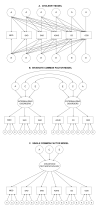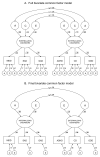Structure and etiology of co-occurring internalizing and externalizing disorders in adolescents
- PMID: 20683651
- PMCID: PMC3036783
- DOI: 10.1007/s10802-010-9444-8
Structure and etiology of co-occurring internalizing and externalizing disorders in adolescents
Abstract
Several studies suggest that a two-factor model positing internalizing and externalizing factors explains the interrelationships among psychiatric disorders. However, it is unclear whether the covariation between internalizing and externalizing disorders is due to common genetic or environmental influences. We examined whether a model positing two latent factors, internalizing and externalizing, explained the interrelationships among six psychiatric disorders (major depressive disorder, generalized anxiety disorder, separation anxiety disorder, attention-deficit/hyperactivity disorder, oppositional defiant disorder, and conduct disorder) in adolescents, and whether there are common genetic and environmental influences on internalizing and externalizing latent factors. Multivariate behavior genetic analyses of data from 1162 twin pairs and 426 siblings ascertained from the general population via the Colorado Center for Antisocial Drug Dependence (CADD) were conducted. We found support for a model positing two latent factors (internalizing and externalizing). These factors were moderately heritable and influenced by significant common genetic and nonshared environmental influences. These findings suggest that co-occurrence of internalizing and externalizing psychopathology in adolescents results from both genetic and environmental influences.
Figures


Similar articles
-
Personality dimensions as common and broadband-specific features for internalizing and externalizing disorders.J Abnorm Child Psychol. 2013 Aug;41(6):939-57. doi: 10.1007/s10802-013-9730-3. J Abnorm Child Psychol. 2013. PMID: 23474797 Free PMC article.
-
Common genetic and nonshared environmental factors contribute to the association between socioemotional dispositions and the externalizing factor in children.J Child Psychol Psychiatry. 2013 Jan;54(1):67-76. doi: 10.1111/j.1469-7610.2012.02621.x. Epub 2012 Sep 28. J Child Psychol Psychiatry. 2013. PMID: 23017065 Free PMC article.
-
Understanding the covariation among childhood externalizing symptoms: genetic and environmental influences on conduct disorder, attention deficit hyperactivity disorder, and oppositional defiant disorder symptoms.J Abnorm Child Psychol. 2005 Apr;33(2):219-29. doi: 10.1007/s10802-005-1829-8. J Abnorm Child Psychol. 2005. PMID: 15839499
-
The role of latent internalizing and externalizing predispositions in accounting for the development of comorbidity among common mental disorders.Curr Opin Psychiatry. 2011 Jul;24(4):307-12. doi: 10.1097/YCO.0b013e3283477b22. Curr Opin Psychiatry. 2011. PMID: 21602684 Free PMC article. Review.
-
Annual research review: phenotypic and causal structure of conduct disorder in the broader context of prevalent forms of psychopathology.J Child Psychol Psychiatry. 2012 May;53(5):536-57. doi: 10.1111/j.1469-7610.2011.02509.x. Epub 2011 Dec 23. J Child Psychol Psychiatry. 2012. PMID: 22211395 Free PMC article. Review.
Cited by
-
Comorbidity Among Dimensions of Childhood Psychopathology: Converging Evidence from Behavior Genetics.Child Dev Perspect. 2015 Mar 1;9(1):26-31. doi: 10.1111/cdep.12102. Child Dev Perspect. 2015. PMID: 26019716 Free PMC article.
-
Validity and utility of Hierarchical Taxonomy of Psychopathology (HiTOP): II. Externalizing superspectrum.World Psychiatry. 2021 Jun;20(2):171-193. doi: 10.1002/wps.20844. World Psychiatry. 2021. PMID: 34002506 Free PMC article.
-
Analysis of cognitive and attentional profiles in children with and without ADHD using an innovative virtual reality tool.PLoS One. 2018 Aug 15;13(8):e0201039. doi: 10.1371/journal.pone.0201039. eCollection 2018. PLoS One. 2018. PMID: 30110334 Free PMC article.
-
Genetics of generalized anxiety disorder and related traits.Dialogues Clin Neurosci. 2017 Jun;19(2):159-168. doi: 10.31887/DCNS.2017.19.2/kdomschke. Dialogues Clin Neurosci. 2017. PMID: 28867940 Free PMC article. Review.
-
Do executive functions explain the covariance between internalizing and externalizing behaviors?Dev Psychopathol. 2018 Oct;30(4):1371-1387. doi: 10.1017/S0954579417001602. Epub 2017 Nov 16. Dev Psychopathol. 2018. PMID: 29144226 Free PMC article.
References
-
- Achenbach TM. Manual for the Child Behavior Checklist/4-18 and 1991 Profile. University of Vermont, Department of Psychiatry; Burlington: 1991.
-
- Angold A, Costello EJ, Erkanli A. Comorbidity. Journal of Child Psychology and Psychiatry. 1999;40:57–87. - PubMed
-
- American Psychiatric Association . Diagnostic and statistical manual of mental disorders. 4th ed Author; Washington, D.C.: 1994.
-
- Burcusa SL, Iacono WG, McGue M. Adolescent twins discordant for major depressive disorder: shared familial liability to externalizing and other internalizing disorders. Journal of Child Psychology and Psychiatry. 44(7):997–1005. - PubMed
-
- Burt SA. Rethinking environmental contributions to child and adolescent psychopathology: a meta-analysis of shared environmental influences. Psychological Bulletin. 2009;135:608–637. - PubMed
Publication types
MeSH terms
Grants and funding
- R01 AA017889/AA/NIAAA NIH HHS/United States
- HD10333/HD/NICHD NIH HHS/United States
- R01 MH043899/MH/NIMH NIH HHS/United States
- MH16880/MH/NIMH NIH HHS/United States
- DA13956/DA/NIDA NIH HHS/United States
- K01 AA015336/AA/NIAAA NIH HHS/United States
- K01 DA013956/DA/NIDA NIH HHS/United States
- HD50346/HD/NICHD NIH HHS/United States
- MH43899/MH/NIMH NIH HHS/United States
- T32 MH016880/MH/NIMH NIH HHS/United States
- DA11015/DA/NIDA NIH HHS/United States
- R01 HD050346/HD/NICHD NIH HHS/United States
- R01 HD010333/HD/NICHD NIH HHS/United States
- AA015336/AA/NIAAA NIH HHS/United States
- P60 DA011015/DA/NIDA NIH HHS/United States
LinkOut - more resources
Full Text Sources
Medical

